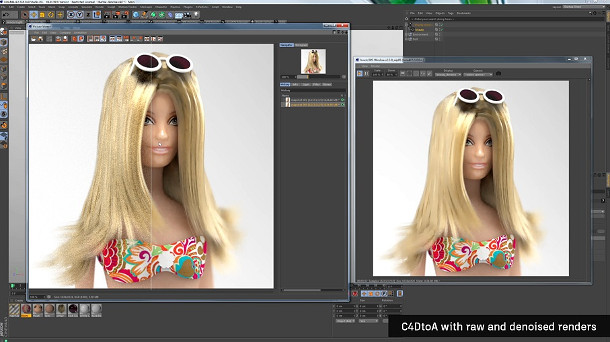Solid Angle ships Arnold 5.1

Solid Angle has released Arnold 5.1, a major update to the renderer, adding a new toon shader, adaptive sampling, native Alembic support, two denoising systems, and an experimental progressive rendering mode.
The integration plugin for Maya has also been updated, with MtoA 3.0 supporting all of the key functionality added in the Arnold 5.1 core.
New non-photorealistic rendering system
One of the most eye-catching features in Arnold 5.1 is the new non-photorealistic rendering system (shown above), which comprises a new toon shader and a contour filter for isolating the edges of objects.
We covered it last month when Autodesk previewed it, so check out our original story for details.

Two new render denoising systems, including Nvidia’s OptiX
The release also introduces two new solutions for denoising renders: the AI-driven denoising system introduced in Nvidia’s OptiX 5.0 framework, and Arnold’s own native denoiser, charmingly titled ‘noice’.
That makes Arnold the latest renderer to adopt OptiX, following V-Ray Next, finalRender and Clarisse.
Both remove noise from renders as a post-process, leading to a usable image in less time than simply allowing the original render to resolve to the same point on its own.
OptiX is a fast, GPU-powered solution, making it well-suited to preview renders, but can leave artefacts in tricky areas of images, so Solid Angle is recommending the CPU-powered noice for final-frame renders.
It takes multiple frames into account, providing more temporal stability; can use multiple light AOVs, including variance information; and can also optionally use normal, depth and albedo when denoising.
Adaptive sampling and progressive rendering
Arnold 5.1 also adds support for adaptive sampling, enabling the renderer to adjust the sampling rate on a per-pixel basis, focusing computational effort on noisier areas of an image to reduce overall render times.
In addition, there is an experimental new progressive rendering mode, which completes a render call in multiple passes.
Solid Angle describes it as still being unoptimised, and “not recommended for batch rendering at high AA samples” due to the time taken to filter the final render passes.
Native support for Alembic and MaterialX
Other changes include native support for the Alembic .abc file format. Maya’s native GPU cache nodes are now exported as an Alembic procedural, with the option to isolate individual sub-objects within the file.
The update also introduces support for MaterialX, Lucasfilm’s open standard for rich material and look dev data, via Arnold 5.1’s operators: a new node type for per-object parameter assignments and overrides.
There is also a long list of smaller features and bugfixes, which you can find in the online changelog.
Pricing and availability
Arnold 5.1 is available for Windows 7+, Linux and Mac OS X 10.8+. The software is due to go rental-only on 30 April 2018, with subscriptions starting at $65/month or $615/year.
Last time we checked, perpetual floating licences cost $1,220, including one year’s maintenance, although Autodesk has now removed the information from its store page, and replaced it with a ‘Contact Sales’ button.
Free integration plugins are available for Maya 2016+, 3ds Max 2018, Cinema 4D R16+, Houdini 13+ and Katana 2.5. The Softimage plugin is now open-source.
At the time of posting, only the Maya plugin supports the features in Arnold 5.1 – although the image further up the story, taken from Autodesk’s blog, shows C4DtoA, the new version hasn’t been released yet.
Read an overview of the key features in Arnold 5.1 on Autodesk’s blog
